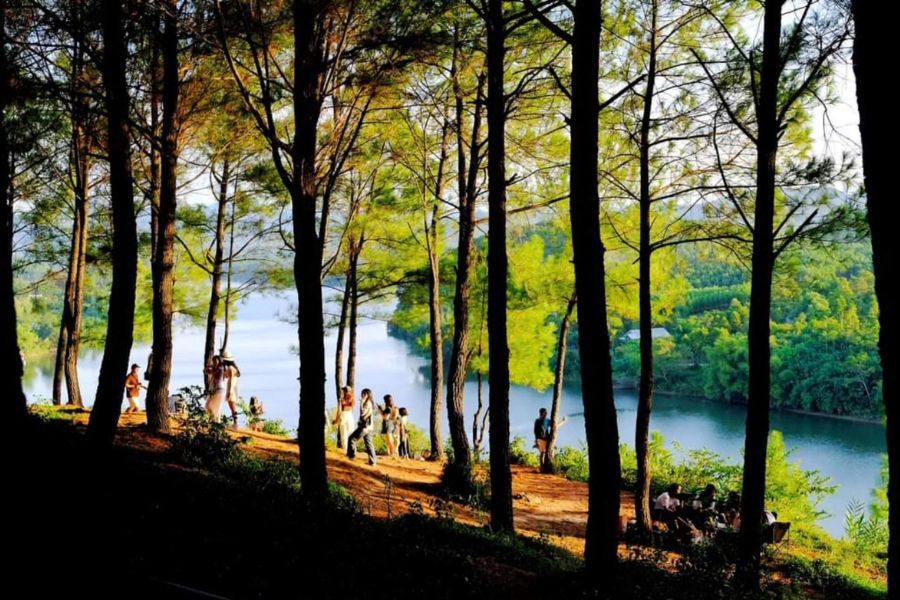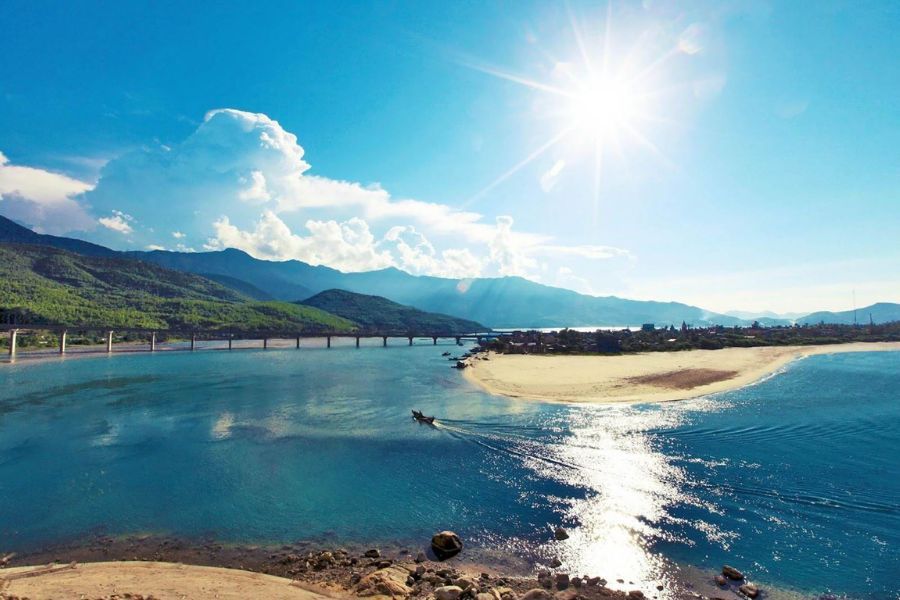Minh Mang Tomb: The Harmony Of Confucian And Taoist Styles
The Minh Mang Tomb is well-known for its strict symmetrical layout, the deep integration, and harmony of Confucian and Taoist philosophies in architecture. The Seni World travel guide will show you its history, cultural experiences, attractions, transportation, and travel tips.
Table of Contents
ToggleIntroduction To The Minh Mang Tomb
The Minh Mang Tomb, situated near the Perfume River (Song Huong) in Hue, is a must-visit destination on any Central Vietnam itinerary. The Mausoleum of Emperor Minh Mang is one of the majestic and architecturally harmonious royal tombs of the Nguyen Dynasty.
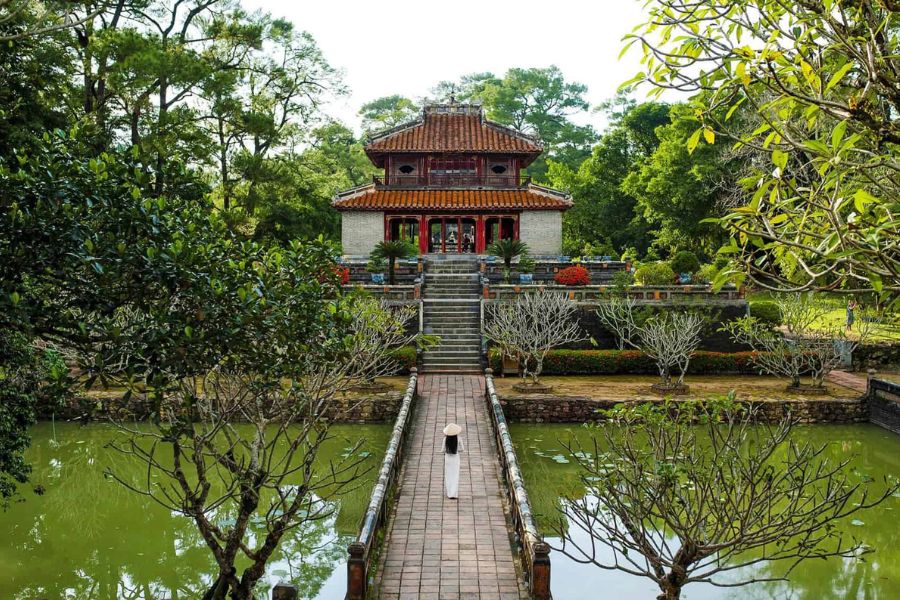
Surrounded by poetic lakes, lush pine forests, and beautifully landscaped gardens, the tomb reflects Emperor Minh Mang’s profound reverence for Confucian ideals, as well as his vision of cosmic harmony. This complex has a symmetrical layout with over 40 structures, consisting of palaces, pavilions, and temples. They are aligned alongside a critical axis, bringing a tranquil and religiously rich enjoyment for visitors.
History Of The Minh Mang Tomb
Creation of the Minh Mang Tomb started in 1840 under Emperor Minh Mang, the second ruler of the Nguyen Dynasty. However, Minh Mang passed away quickly after the project began. His successor, Emperor Thieu Tri, finished the tomb in 1843.
This complex was carefully selected for its feng shui alignment, showcasing concord among heaven, earth, and man. The mausoleum is not only Minh Mang’s final resting area, but it is also a long-lasting testimony to his strong leadership, cultural reforms, and efforts to centralize imperial authority throughout his reign.
Unique Architecture Of The Minh Mang Tomb
The Minh Mang Tomb is well-known for its strict symmetrical layout and the deep integration and harmony of both Confucian and Taoist philosophies in architecture. Here are 5 unique architectural features of the Minh Mang Tomb, one of the wonderful attractions in Hue, for you:
Perfect Symmetry And Balanced Layout
The Mausoleum of Emperor Minh Mang is famous for its strict symmetrical layout alongside a vital axis that runs from the main gate of the tomb to the emperor’s tomb. Each architectural point, such as gates, pavilions, bridges, and temples, is situated in perfect harmony, demonstrating stability and order in governance, as well as the main mindset of Emperor Minh Mang.
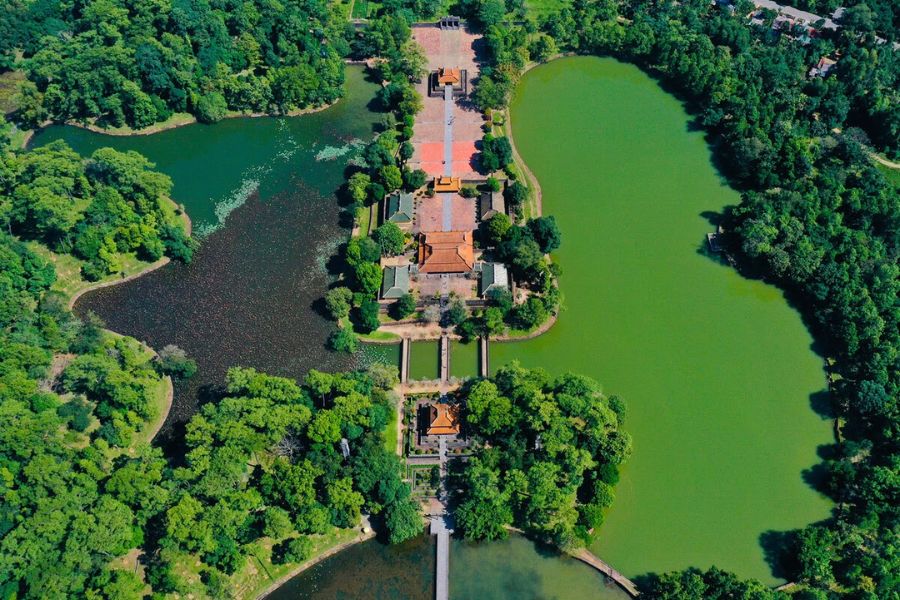
Nhi Thap Bat Tu Style
Nhi Thap Bat Tu in architecture means 28 buildings in total, or the complex of 28 architectural systems. This is an iconic image representing the 28 lunar mansions in Eastern culture and cosmology. It displays deep integration and harmony of both Confucian and Taoist philosophies into the tomb’s creation and building, particularly an emperor’s tomb.
Fusion Of Nature And Architecture
Surrounded by green, lush gardens, poetic lakes, and great pine forests, the mausoleum is designed as a beautiful landscape painting. All structures are carefully located among various natural elements, consisting of the Trung Minh Lake and Ngu Mountain, making a quiet and peaceful atmosphere, reflecting Minh Mang’s vision and mission of a great realm.
Symbolic Bridges And Pavilions
Wandering into the central area of the complex, you will have a chance to pass over symbolic bridges like Trung Dao Bridge, which has the meaning of the road from the earthly world to the religious one. Besides, the Minh Lau Pavilion (Pavilion of Light) here showcases the emperor’s wisdom and legacy, positioned on a small hill with the whole perspective of the complex.
Use Of Traditional Imperial Architecture
The Minh Mang Tomb displays the strongly traditional Nguyen Dynasty architectural style, consisting of curved and tiled roofs with dragon motifs, ornate and carefully wood-carved decorations, and the iconic imperial red and yellow colors. This traditional building approach reinforces Minh Mang’s role at the time, who was a ruler deeply rooted and thought in Confucian values as well as Vietnamese heritage.
4 Cultural Experiences You Shouldn’t Miss In The Minh Mang Tomb
Besides investigating the great architecture of the Minh Mang Tomb, you can also have cultural experiences around this place. Here are 3 cultural experiences you shouldn’t miss when exploring this emperor’s tomb in the Hue itinerary:
Explore Traditional Imperial Temple Ceremonies
Stroll through the Hien Duc Gate and worship temples, and you will see offerings and incense, especially during the unique rituals. These ceremonies are an important part of keeping the cultural practice of ancestor worship and show reverence for Vietnam’s past. Local people and travelers will respectfully place fruit, incense, and symbolic objects on the altars.
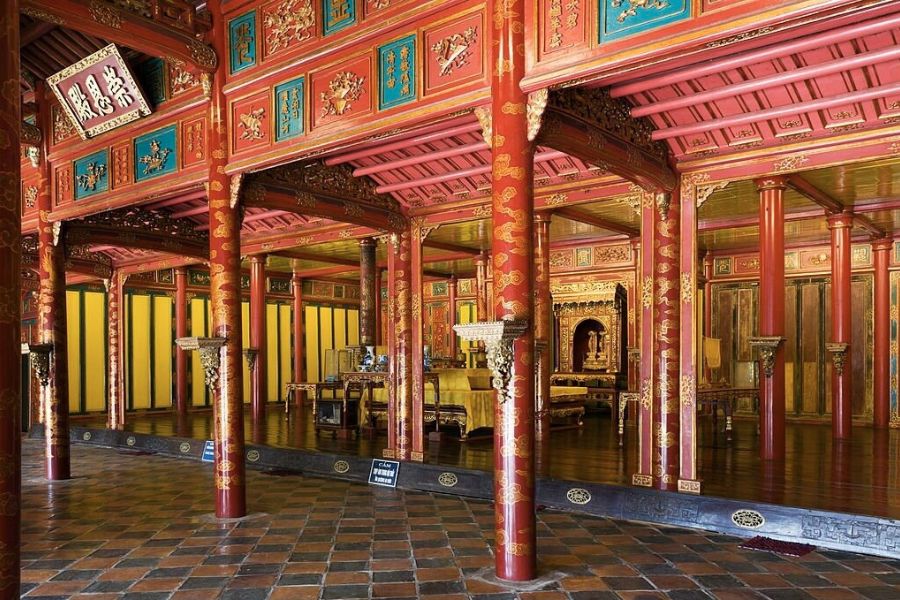
Discover Mythical Creatures in Decorative Motifs
Visiting the Minh Mang Tomb, you will have a chance to see intricate carvings of dragons, phoenixes, turtles, and unicorns, which are the four sacred animals in Vietnamese legend and mythology. Each of them has a cultural meaning, including dragons for strength, phoenixes for peace, turtles for longevity, and unicorns for justice. They are intricately embedded in gates, roofs, and altars.
Take In The Imperial Garden Landscaping Techniques
The Minh Mang Tomb complex is a living museum of the Nguyen Dynasty royal scenery. Don’t miss out on seeing how all plants, lotus ponds, and bonsai trees are carefully decorated to beautify the natural balance of this place. It also displays conventional feng shui concepts and principles, as well as a cultural belief that if nature is shaped properly, it will bring spiritual harmony and power.
Revel In The Traditional Dishes Of Hue
Traveling to Hue, don’t forget to try various iconic Hue dishes, including Bun Bo Hue (Spicy Beef Noodle Soup), Com Hen (Clam Rice), Nem Lui (Grilled Pork Skewers), Cha Hue (Hue-Style Sausage), and Banh Khoai (Crispy Vietnamese Pancake). Besides, you can try to enjoy royal foods in some luxurious restaurant, including Vit Nau Chao (Fermented Tofu Duck Hotpot), or Ga Tiem Ngu Qua (Steamed Chicken With Five Fruits),…
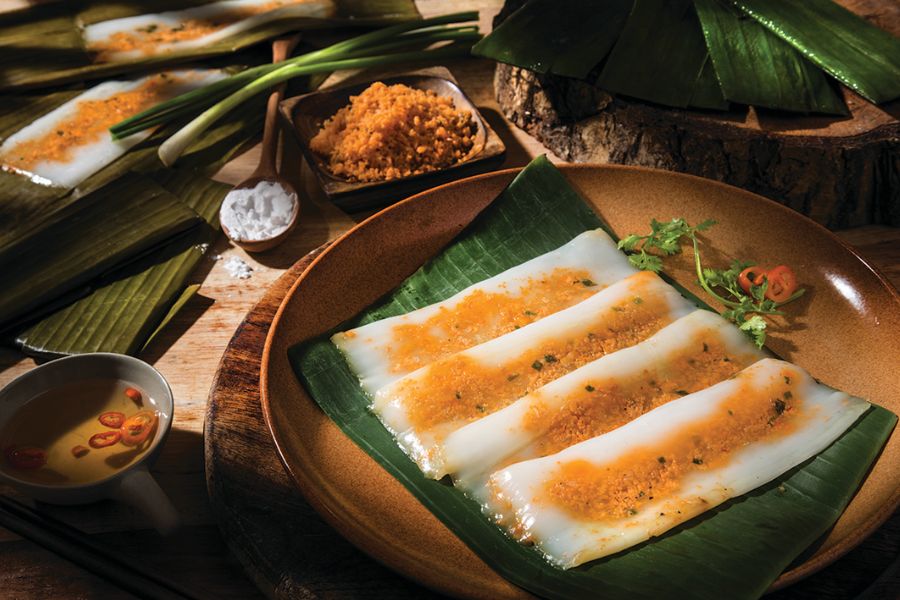
Entrance Fee Of The Minh Mang Tomb
Here is a table that Seni World has summarized the Minh Mang Tomb entrance fee in Hue. Besides, we have also collected combo tickets, including the Minh Mang Tomb, for you to refer to:
| Ticket Type | Adult (from 13 years old) | Child (7 to 12 years old) | Child Under 7 |
| The Minh Mang Tomb | 150,000 VND | 30,000 VND | Free |
| Imperial City, the Minh Mang Tomb, and the Tu Duc Tomb | 420,000 VND | 80,000 VND | Free |
| Imperial City, the Minh Mang Tomb, and the Khai Dinh Tomb | 420,000 VND | 80,000 VND | Free |
| Imperial City, the Minh Mang Tomb, the Tu Duc Tomb, and the Khai Dinh Tomb | 530,000 VND | 100,000 VND | Free |
Opening Hours Of The Minh Mang Tomb
The Minh Mang Tomb opening hours are from 07:00 AM to 05:00 PM on all days of the year, and sometimes from 07:00 am to 04:30 pm. However, if arriving after 04:00 pm, it is harder for you to visit fully because of its large. Therefore, you should choose to visit here before then.
The period from January to April, especially from February to April, is the best time to visit Hue as well as the Minh Mang Tomb. This is the reason why the open hours of this attraction can be different. Therefore, you need to carefully ask the manager of this destination before booking the ticket to explore.
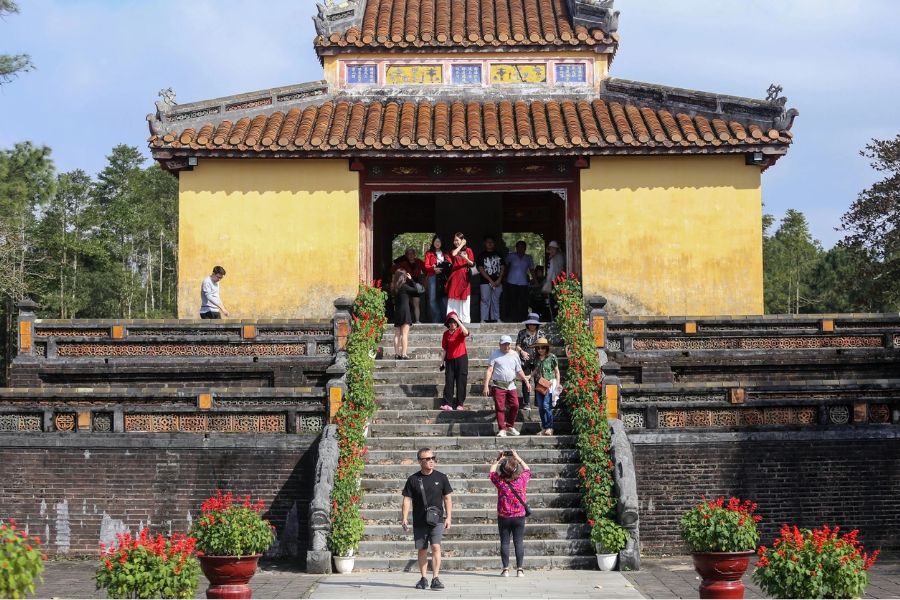
How To Get To The Minh Mang Tomb
Arriving at the Minh Mang Tomb from the Hue city center, you should opt for the right way to be comfortable and have a low price. Here are hints from Seni World about how to get to the famous Mausoleum of Emperor Minh Mang in Hue:
| Mode Of Transport | Typical Travel Time (From Hue City Center) | Estimated Cost (VND) | Notes |
| Taxi | From 25 to 30 minutes | About 120,000 to 180,000 VND | This is a convenient choice and ideal for groups or travelers looking for comfort. |
| Motorbike | From 25 to 30 minutes | About 100,000 to 150,000 VND per day (rental) | Motorbikes are adventurous, flexible, and you can easily rent one at lodgings or local rental shops. |
| Bike | From 50 to 70 minutes | About 50,000 VND per day (rental) | Biking is an eco-friendly option of transportation, and you can have a scenic ride along quiet roads. It is good if the weather is pleasant. |
| Dragon Boat and then Walk | The total is about 90 minutes | About 200,000 to 400,000 VND (the boat rental) | You need to take a boat from the Perfume River (Song Huong) pier to the nearby wharf, then walk about 1 km to reach the Minh Mang Tomb. |
| Tour Service | Half-day or full-day | About 300,000 to 800,000+ VND | The tour service includes a local guide and typically features multiple attractions, such as the combination of the Tu Duc Tomb, the Khai Dinh Tomb, and the Minh Mang Tomb. |
| Private Car | From 25 to 30 minutes | About 400,000 to 600,000 VND (the round trip) | This is the best choice for convenience, groups, and families. You can share the cost and feel relaxed. |
Things To Know Before Traveling To The Minh Mang Tomb
To have a comfortable, exciting, and memorable trip to the Minh Mang Tomb in Hue, please remember the following important travel tips. These tips will help you discover this attraction conveniently, but still respect the spirituality, culture, and protect yourself best:
- The pleasant time: You should go to the Minh Mang Tomb in the early morning or in the late afternoon to keep away from crowds and heat.
- Protect your skin: Particularly in the Summer season, you need to remember to apply sunscreen with high SPF, and wear a hat to protect your skin.
- Bring insect repellent: The tomb is surrounded by water and gardens, so mosquitoes can be a problem for travelers, especially in summer. Remember to bring insect repellent to protect yourself.
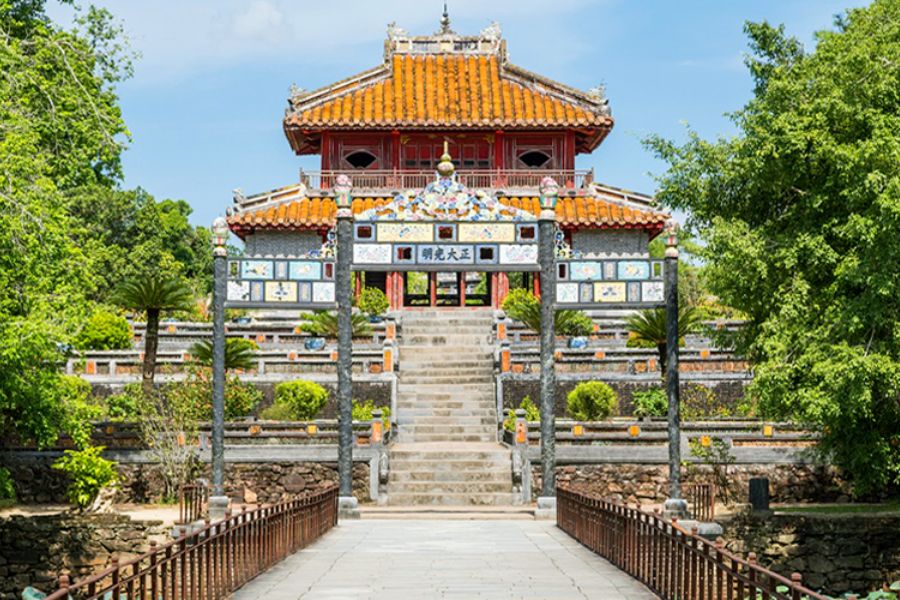
- Stay hydrated: Prepare a bottle of water to make sure that your body has enough water in the sun when strolling around the Minh Mang Tomb.
- Wear comfortable walking footwear: When going to the Minh Mang Tomb, there are steep stairs as well as uneven stone paths, so wearing suitable walking shoes is essential.
- Arrange a combo of visiting: Because of the relation and the nearby areas, you can integrate the exploration of the Minh Mang Tomb with close by tombs like the Tu Duc Tomb and the Khai Dinh Tomb for a full day of history, culture, and memories of the past.
- Bring the valid ID for your children: The Mausoleum of Emperor Minh Mang offers reductions available for children and students with a valid ID. Let’s bring it for a ticket-off if you have children.
- Get dressed respectfully: You need to wear clothing politely and respectfully (with shoulders and knees covered), particularly if coming into any shrine regions here.
- Don’t be noisy: Remember to avoid loud behavior because this is a historic and spiritual attraction. Let’s have respectful behavior and voice.
- Prepare cash: You need to bring cash (VND or Vietnam Dong) for buying tickets and some small purchases because ATM are not common at this destination.
- Check the weather forecast: In Hue, the weather can be hot and humid or sometimes heavy rains, depending on the travel season, which you opt for to arrive here. Therefore, you need to remember to take a look at and carefully check the weather forecast in advance, and plan accordingly.
Final Thoughts: Is The Minh Mang Tomb Worth Visiting?
The Minh Mang Tomb is a symbolic attraction in Hue, which has a strict symmetrical layout and the deep integration and harmony of both Confucian and Taoist philosophies in architecture. If you want to take a Minh Mang Tomb adventure, as well as consult about interesting things to do in Hue, and receive support for the visa process, let’s contact Seni World, a reputable tour operator from Vietnam. We are here to help you from A to Z on your Minh Mang Tomb discovery journey.










